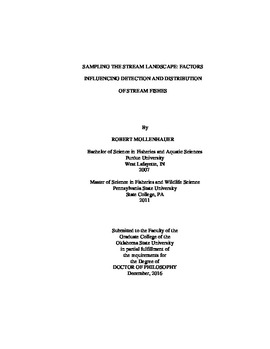| dc.contributor.advisor | Brewer, Shannon K. | |
| dc.contributor.author | Mollenhauer, Robert | |
| dc.date.accessioned | 2018-06-25T13:38:25Z | |
| dc.date.available | 2018-06-25T13:38:25Z | |
| dc.date.issued | 2016-12 | |
| dc.identifier.uri | https://hdl.handle.net/11244/300254 | |
| dc.description.abstract | Stream fishes are among the most threatened species due to natural flow regime alterations and fragmented habitats stemming from both anthropogenic activities and climate change. A fundamental challenge of establishing stream fish-environment relationships is variable detection (the proportion of available individuals captured or the probability of detecting a species when present), which confounds perceived species distributions. My overarching goals were to improve detection estimates for common stream-fish sampling methods and identify multiscale factors related to stream-fish distributions in Ozark Highland streams. I used gear calibration to model tow-barge electrofishing detection among stream fishes across environmental conditions at multiple spatial scales. Multiple stream reach-scale variables were associated with stream-fish detection including water depth and clarity, emergent vegetation, and a discharge-proportion riffle interaction, where the magnitude of these relationships varied among species in relation to habitat use. Lithological characteristics of stream segments explained additional variation in stream-fish detection. I compared snorkeling to tow-barge electrofishing to examine tendencies in the number of species detected and evaluated the efficacy of snorkel counts for estimating stream-fish abundance. Electrofishing tended to detect more rare species than snorkeling. Snorkeling typically underestimated stream-fish abundance, particularly for cryptic species such as Green Sunfish and Rock Bass; however, snorkeling did provide informative population estimates for Smallmouth Bass. I improved the applicability of electrofishing for monitoring stream-dwelling Smallmouth Bass using a multinomial N-mixture model. Water clarity, effort, and a wetted channel width-water depth interaction explained variation in Smallmouth Bass detection. Smallmouth Bass abundance estimates derived from the model agreed with baseline estimates obtained via snorkeling. Empirical Bayes confidence intervals for Smallmouth Bass abundance from the model were more precise than unbiased Petersen mark-recapture estimates. Lastly, I examined stream fish-environment relationships at multiple spatial scales. Variation in stream-fish densities were associated with stream reach-scale groundwater contribution and stream segment-level lithology. Variation in stream-fish occurrence was associated with riffle-run-pool sequence area and stream reach-scale substrate size, groundwater contribution, and residual pool depth. My project highlights the complexity of stream-fish detection across environmental conditions and the importance of multiscale approaches for examining stream-fish environment relationships and contributes to advancements in stream-fish ecology and management. | |
| dc.format | application/pdf | |
| dc.language | en_US | |
| dc.rights | Copyright is held by the author who has granted the Oklahoma State University Library the non-exclusive right to share this material in its institutional repository. Contact Digital Library Services at lib-dls@okstate.edu or 405-744-9161 for the permission policy on the use, reproduction or distribution of this material. | |
| dc.title | Sampling the stream landscape: Factors influencing detection and distribution of stream fishes | |
| dc.contributor.committeeMember | Peterson, James | |
| dc.contributor.committeeMember | Shoup, Daniel E. | |
| dc.contributor.committeeMember | Fox, Garey A. | |
| osu.filename | Mollenhauer_okstate_0664D_14894.pdf | |
| osu.accesstype | Open Access | |
| dc.type.genre | Dissertation | |
| dc.type.material | Text | |
| thesis.degree.discipline | Natural Resource Ecology and Management | |
| thesis.degree.grantor | Oklahoma State University | |
